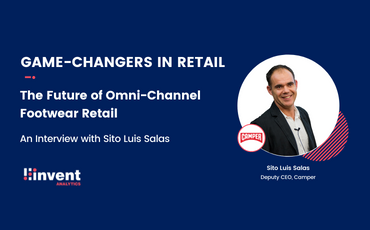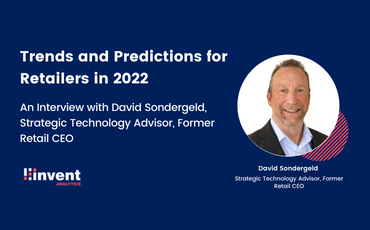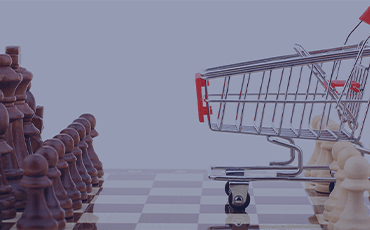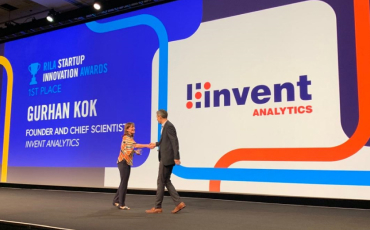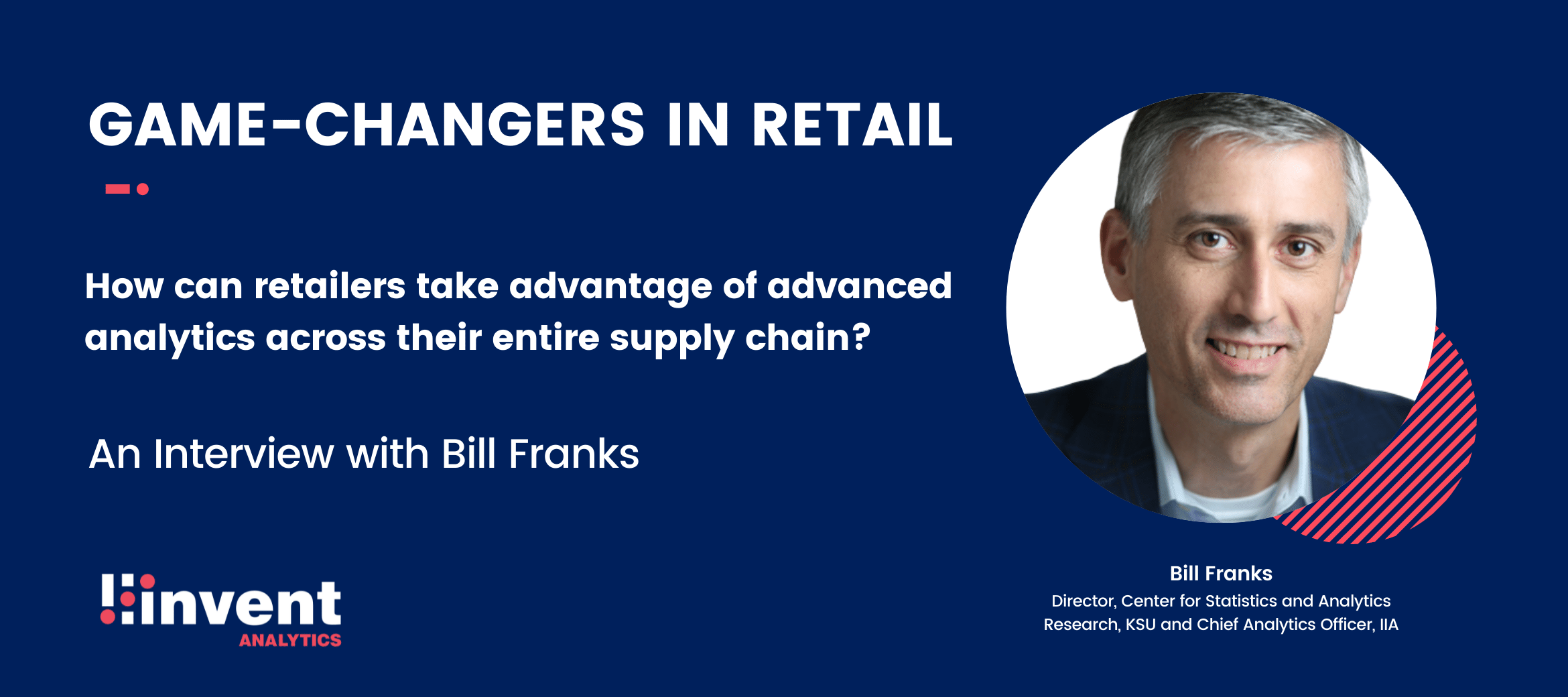
Taking Advantage of Advanced Analytics Across Retail Supply Chains
Game-changers in Retail: An Interview with Bill Franks, Director, Center for Statistics and Analytics Research, KSU and Chief Analytics Officer, IIA
There has been a revolution in retail in the last couple of years. Today retail is becoming an increasingly data-rich environment. As the volume and value of the data are increasing exponentially, there are many opportunities for retailers to do better inventory planning, improve customer experience and become more profitable.
As a part of our Game-changers in Retail series, we’ve had the pleasure of interviewing Bill Franks, Director, Center for Statistics and Analytics Research, KSU and Chief Analytics Officer, IIA. We asked his expert opinion on how retailers can take advantage of advanced analytics across their entire supply chain and use data to gain a competitive advantage.
Today retailers have access to massive customer data coming from various channels. How can they use this data to gain a competitive advantage?
I think retailers will always be on the lookout for new data sources that are available and useable. If we go back in time, not even a decade, it was difficult to use data, such as web browsing data. Whereas today, there are all sorts of new data sources available, such as a text conversation via a typed chat window or a transcribed live conversation. There are also IoT devices that became suddenly available that weren’t in existence before. These devices produce all sorts of interesting data, including movement patterns, eye tracking, and more.
Any time retailers have additional data, they can explore how to leverage it to address their customers. To give customers good service and a positive experience, retailers should use all the information they have so that they can be relevant and interesting for their customers.
From a data analytics perspective, what do you think should be the 3 key priorities for retailers in a post-pandemic world?
First, retailers need to dig into what worked differently during the pandemic. Obviously, a lot of things changed, and I think things will continue to evolve. What is working well now and what was working a year ago probably are not the exact same things. So, retailers need to constantly look for where something is changing and analyze it. They need to follow up on the new trends or patterns emerging that they haven’t seen before so they can determine how to best address them.
Second, I think the big open question is whether we ever get back to exactly how things were or somewhere between where we are now and where things were? As things changed quickly during the pandemic, they can go back to normal very quickly as well. So, retailers need to be agile overall and adjust their strategies accordingly. They need to continually analyze their data to find the latest patterns. It isn’t a “one and done” exercise.
And the third thing would be keeping the learnings from this pandemic as indicative of what they might expect in a future disruption, whether it is a pandemic or some other type of event that can have a similar impact. The hardest thing in analytics is that you can’t predict what’s going to happen when you are in a scenario where you have no historical data on which to base that prediction. We now have such data for many scenarios from this pandemic that would have been considered virtually impossible or highly unusual two years ago.
How important do you think it is to use predictive analytics for inventory optimization?
I think it’s critical, and it comes down to how everything is connected. So many companies focus on consumer analytics to give customers excellent and relevant offers and get them to come and shop. But obviously, all those efforts are pointless if they go to the store and find empty shelves and the items they would like to purchase are out of stock.
So, I think retailers should look at various aspects of their inventory processes. They need to know what is coming in in the supply chain, the current status of their stores, and the historical volume on a seasonal basis. There are a lot of underlying trends retailers must account for to keep inventory at an optimal level, and they have to be able to adjust quickly.
What are some of the challenges with inventory optimization?
There are so many constraints in the inventory and supply chain areas that we don’t control. One of the big things in the news today are the shipping delays. When retailers start to see shipping delays, they better react quickly. Does that mean that they expedite their current orders? Do they make a variety of additional orders from various vendors and hope that at least a certain percentage of the orders will get through even though they just don’t know which ones will make it?
While there is not necessarily a perfect answer, if they have the right analytics, they should be able to have a good view of approximately how short they’re going to be based on the current studies. And they can take some defensive actions to attempt to fill that gap.
The reality is that most products and most retail settings are pretty stable in terms of their sell-through rate and have predictable patterns even when they spike. Think about Halloween candy, for example. The big sales lifts during Halloween are predictable. Through analytics, retailers know how much higher demand is expected to be during the holiday season, and they can plan ahead.

How do you think retailers can take advantage of advanced analytics across their entire supply chain?
Retailers should build models to predict what to expect at all points through their supply chain. They need to have models looking at manufacturing plants to see how they are operating, if they are on schedule or not, if the supplies are coming in on time, and how much delay they might face. They also need to look at distribution centers, to see if they have the space, staff, and trucks to get the products to and from the centers.
There are so many points in the supply chain that must be navigated to get a product from a manufacturing plant into consumers’ hands. It is an incredibly complicated ecosystem. Each of these various pieces can and are being monitored today. Each part of the supply chain should have a variety of basic tracking analytics available, and of course, some predictive analytics can be applied too.
When port traffic jams, driver shortages, and other factors outside of a retailer’s control hit, what can they do? Can analytics help?
Retailers need to accept that regardless of how data-driven they are as an organization, there are times when they won’t have the data they need, and they have to make the best call they can. The pandemic has given us a lot of circumstances that we do now have data on, and this data can be used in the future to project how things might play out when something similar happens.
I have talked to all different types of retailers, from home improvement to grocery. They have been through many hurricanes, tornados, and blizzards. So now they have a pretty good idea about what to expect both before and after a hurricane as stores start to reopen. It doesn’t mean that it is not difficult and painful to go through that process, but with their experience, they know which products they need to stock up on and ship more of and which ones they can hold off on. It will be a very similar scenario with the pandemic. At least now, retailers will have data. In the future, if something similar happens that causes lockdowns or increases in staying at home for extended periods, they won’t be flying totally blind.
What do you think will be the key analytics trends shaping the retail landscape in the omni-channel world?
It is hard to predict what kind of new data we’ll have access to eventually. For example, eye tracking would be something we would hardly think of and would have considered science fiction not that long ago. But now retailers can take advantage of it.
I think the other thing that will continue is the requirement for completely blurring lines of various channels. Now consumers don’t necessarily differentiate the online and in-store channels from a brand perspective. They just want to interact with the brand in whatever is most convenient at the time.
From a traditional retail perspective, one of the most significant changes that is probably here to stay, is tied to distribution strategies. Retailers now either have mini local distribution centers that are independent of stores, or they are using stores as their local distribution centers. It obviously requires whole other layers of analytics to shift distribution responsibilities from a few large, centralized locations to a broader range of smaller, decentralized locations. It is challenging for retailers, but many advantages can come with those challenges if the retailers get the analytics right.

Thank you Bill.
Did you enjoy reading this? You might also be interested in reading Game-changers in Retail: An Interview with Michelle Gloeckler, Game-changers in Retail: An Interview with Maksym Tipukhov, Game-changers in Retail: An Interview with Justin Honaman


